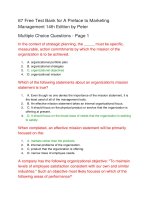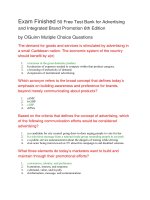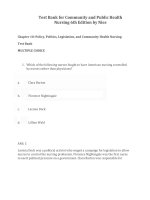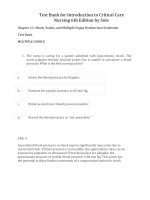Test bank for priorities in critical care nursing 6th edition by urden
Bạn đang xem bản rút gọn của tài liệu. Xem và tải ngay bản đầy đủ của tài liệu tại đây (55.09 KB, 6 trang )
buy this full document at
Urden: Priorities in Critical Care Nursing, 6th Edition
Chapter 01: Caring for the Critically Ill Patient
Test Bank
MULTIPLE CHOICE
1. Which of the following best describes the difference between the roles of the clinical nurse
specialist (CNS) and the acute care nurse practitioner (ACNP)?
a.
b.
c.
d.
The CNS has prescriptive authority and works with individual patients.
The ACNP has prescriptive authority and works with groups of patients.
The CNS works only as a consultant.
The ACNP works only with families.
ANS: B
ACNPs manage clinical care of a group of patients and have various levels of prescriptive
authority, depending on the state and practice area in which they work. They also provide
care consistency; interact with families; plan for patient discharge; and provide teaching to
patients, families, and other members of the heath care team.
DIF: Cognitive Level: Comprehension
REF: 1
OBJ: Nursing Process: Implementation
TOP: Advanced Practice
MSC: NCLEX: Safe and Effective Care Environment: Management of Care
2. The framework for critical care nurses is based on what authoritative standards?
a. The Joint Commission’s National Patient Safety Goals
b. American Association of Critical-Care Nurses (AACN) Standards of Care
c. American Hospital Association algorithms
d. Centers for Disease Control and Prevention Emergency Preparedness Guidelines
ANS: B
The AACN has established nursing standards to provide a framework for critical care nurses.
The standards are authoritative statements that describe the level of care and performance by
which the quality of nursing care can be judged. Standards serve as descriptions of expected
nursing roles and responsibilities.
DIF: Cognitive Level: Knowledge REF: 1
OBJ: Nursing Process: Implementation
TOP: Standards of Care
MSC: NCLEX: Safe and Effective Care Environment: Management of Care
3. The rationale for using evidence-based practice is to:
a. produce consistent, positive outcomes.
b. justify the actions of providers.
c. convince insurance companies to pay.
d. provide legal protection for providers.
buy this full document at
Full file at />ANS: A
By basing practice on scientific findings, with their ability to explain and predict, nurses are
able to provide research-based interventions with consistent, positive outcomes.
DIF: Cognitive Level: Comprehension
REF: 2
OBJ: Nursing Process: Implementation
TOP: Evidence-based Practice
MSC: NCLEX: Safe and Effective Care Environment: Management of Care
4. Practice Alerts promoted by the AACN are:
a. descriptive warnings of hazardous practices.
b. quick references for practice areas.
c. notices of violations of the Nursing Practice Act.
d. simulated situations for practicing difficult techniques.
ANS: B
The AACN has promulgated several practice summaries in the form of Practice Alerts. These
alerts are short directives that can be used as a quick reference for practice areas (e.g., oral
care, noninvasive blood pressure monitoring, ST-segment monitoring). They are succinct and
supported by evidence and address both nursing and multidisciplinary activities. Each alert
includes the clinical information, followed by references that support the practice.
DIF: Cognitive Level: Comprehension
REF: 2
OBJ: Nursing Process: Implementation
TOP: Evidence-based Practice
MSC: NCLEX: Safe and Effective Care Environment: Management of Care
5. An algorithm used in the care and treatment of the critically ill patient is the:
a. AACN Standards of Care.
b. advanced cardiac life support algorithms published by the American Heart
Association.
c. state board of nursing state practice act.
d. National League for Nursing’s Center for Nursing Advocacy Mission Statement.
ANS: B
An algorithm is a stepwise decision-making flowchart for a specific care process or
processes. Algorithms are more focused than clinical pathways and guide the clinician
through the “if, then” decision-making process, addressing patient responses to particular
treatments. Well-known examples of algorithms are the advanced cardiac life support
algorithms published by the American Heart Association.
DIF: Cognitive Level: Comprehension
REF: 4
OBJ: Nursing Process: Implementation
TOP: Care Management Tools
MSC: NCLEX: Safe and Effective Care Environment: Management of Care
6. The nurse best demonstrates an understanding of holistic care by:
a. explaining the use of the continuous blood pressure monitoring device to the
Copyright © 2012, 2008, 2004, 2000, 1996, 1992 by Mosby, an imprint of Elsevier Inc.
Full file at />family.
b. using active listening with a patient who is fearful and anxious.
c. incorporating other disciplines into the plan of care.
d. reviewing the list of home medications with a family member.
ANS: B
The critical care nurse must be able to deliver high-quality care skillfully, using all
appropriate technologies, while incorporating psychosocial and other holistic approaches, as
appropriate, given time and the patient’s condition.
DIF: Cognitive Level: Synthesis REF: 2
OBJ: Nursing Process: Implementation
TOP: Holistic Care
MSC: NCLEX: Safe and Effective Care Environment: Management of Care
7. Which of the following activities has demonstrated an impact on decreasing distractions in the
critical care unit?
a.
b.
c.
d.
Allowing no visitors into the unit while physicians make rounds.
Restricting visitors to only one at a time at the patient’s bedside.
Performing nurse-to-nurse handoffs at the nursing station.
Establishing a “no interruption zone” around the medication preparation area.
ANS: D
Medication administration continues to be one of the most error-prone nursing interventions
for the critical care nurse. Many medication errors are related to system failures; specifically,
distraction is a major factor. Various interventions have been created in an attempt to
decrease medication errors. Most recently, a published study reported establishing a “no
interruption zone” for medication safety in an intensive care unit. In this pilot study, there
was a 40% decrease in interruptions from the baseline measurement.
DIF: Cognitive Level: Analysis
REF: 5
OBJ: Nursing Process: Implementation
TOP: Patient Safety
MSC: NCLEX: Safe and Effective Care Environment: Management of Care
8. Ways that critical care nurses can ensure that individual differences related to culture are
incorporated into the plan of care include:
a.
b.
c.
d.
asking the patient/family about cultural beliefs that may apply.
asking the patient/family to comply with the hospital culture.
using a standardized plan of care for consistency.
formulating lists of cultural characteristics that apply to all group members.
ANS: A
Nurses must possess knowledge about biocultural, psychosocial, and linguistic differences in
diverse populations to make accurate assessments. Interventions must then be tailored to
address the uniqueness of each patient and family.
DIF:
Cognitive Level: Analysis
REF: 3
Copyright © 2012, 2008, 2004, 2000, 1996, 1992 by Mosby, an imprint of Elsevier Inc.
Full file at />OBJ: Nursing Process: Assessment TOP: Holistic Care
MSC: NCLEX: Safe and Effective Care Environment: Management of Care
9. Which of the following is an example of a healthy work environment?
a. Physician belittling a nurse for not knowing a patient’s secondary diagnosis.
b. Nurse not following a physician’s order because she did not understand it.
c. Nurse collaborates with a physician regarding a patient’s need for palliative care.
d. Nurse rolling his/her eyes when asked a question by a new graduate nurse.
ANS: C
A nurse collaborating with a physician regarding a patient’s needs is an example of Standard
II – True Collaboration.
DIF: Cognitive Level: Analysis
REF: Box 1-3
OBJ: Nursing Process: Assessment TOP: Healthy Work Environment
MSC: NCLEX: Safe and Effective Care Environment: Management of Care
MULTIPLE RESPONSE
1. Critically ill patients receive better care in hospitals when they are: (Select all that apply)
a. mechanized.
b. multidisciplinary.
c. specialized.
d. holistic.
ANS: B, C, D
Critical care today is provided to patients by a multidisciplinary team of health care
professionals who have in-depth education in the specialty field of critical care. It should be
holistic in nature.
DIF: Cognitive Level: Comprehension
REF: 2
OBJ: Nursing Process: Implementation
TOP: Holistic Care
MSC: NCLEX: Safe and Effective Care Environment: Management of Care
2. Special capabilities that clinical nurse specialists (CNSs) bring to the care of the critically ill patient
include: (Select all that apply)
a.
b.
c.
d.
e.
providing routine bedside care.
conducting research.
offering spiritual support.
consulting.
providing discharge planning.
ANS: B, D
CNSs serve in specialty roles that require clinical, teaching, research, leadership, and
consultative abilities.
Copyright © 2012, 2008, 2004, 2000, 1996, 1992 by Mosby, an imprint of Elsevier Inc.
Full file at />DIF: Cognitive Level: Comprehension
REF: 1
OBJ: Nursing Process: Implementation
TOP: Advanced Practice
MSC: NCLEX: Safe and Effective Care Environment: Management of Care
3. Protocols are distinguished from pathways or guidelines by which of the following? (Select all that
apply)
a.
b.
c.
d.
They are used in research.
They are more directive and rigid.
They have more flexibility in use.
They are cyclic.
ANS: A, B
A protocol is a common tool in research studies. Protocols are more directive and rigid than
pathways or guidelines, and providers should not vary from a protocol. Patients are screened
carefully for specific entry criteria before being started on a protocol. The many national
research protocols include those for cancer and chemotherapy studies.
DIF: Cognitive Level: Application REF: 4
OBJ: Nursing Process: Implementation
TOP: Holistic Care
MSC: NCLEX: Safe and Effective Care Environment: Management of Care
4. Especially in a critical care unit, patient safety is an ethical imperative because: (Select all that
apply)
a.
b.
c.
d.
surveillance is more prevalent and the nurses’ actions are scrutinized.
the highly complex environment makes errors and accidents more likely.
patients are vulnerable because of their compromised state.
the high-technology setting decreases risk of errors and omissions.
ANS: B, C
Patient safety has been described as an ethical imperative, and one that is implied in health
care professionals’ actions and interpersonal processes. Critical care units are prime
examples of settings in which errors may occur because of the hectic, complex environment
where the margins of error are narrow and the demands for safety are crucial. In this
environment, patients are particularly vulnerable because of their compromised physiological
status, need for multiple technological and pharmacological interventions, and care by
multiple providers who frequently work at a fast pace.
DIF:
OBJ:
TOP:
MSC:
Cognitive Level: Comprehension
REF: 4
Nursing Process: Planning
Patient Safety
NCLEX: Safe and Effective Care Environment: Management of Care
5. The regulations of the Health Insurance Portability and Accountability Act have which special
implications for the provider of care in the critical care environment? (Select all that apply)
a. Privacy must be maintained in close working conditions.
b. Only as much information as the patient/family needs should be disclosed.
Copyright © 2012, 2008, 2004, 2000, 1996, 1992 by Mosby, an imprint of Elsevier Inc.
Full file at />c. The care provider must be honest and accurate in reporting patient-related
information.
d. Confidentiality must be preserved when speaking with family members.
ANS: A, D
The Health Insurance Portability and Accountability Act of 1996 has created additional
challenges for health care organizations and providers because of the stringent requirements
of the law and the additional resources needed to meet these requirements. Most relevant for
critical care clinicians is the requirement for privacy and confidentiality related to protection
of health care data. This has implications for interacting with family members, as well as
others, and for providing care in the oftentimes very close work environment, tight working
spaces, and emergent situations. Clinicians are referred to their organizational policies and
procedures for specific procedures and requirements in their particular work setting.
DIF:
OBJ:
TOP:
MSC:
Cognitive Level: Application REF: 5
Nursing Process: Planning
Confidentiality
NCLEX: Safe and Effective Care Environment: Management of Care
Copyright © 2012, 2008, 2004, 2000, 1996, 1992 by Mosby, an imprint of Elsevier Inc.









